AIR SPOTLIGHT
TOURISM IN INDIA

Disclaimer: Copyright infringement not intended
Context
- The Union Cabinet has approved the expansion of the Emergency Credit Line Guarantee Scheme (ECLGS) by Rs 50,000 crore to Rs 5 lakh crore - the additional funds will be made available exclusively for the travel, tourism and hospitality sectors
- The corpus will be given by the Central government which will be Rs 7,500 crore for FY 2022-23.
- The ECLGS scheme was launched in the wake of the pandemic to help small enterprises struggling amid the unprecedented hit to economic activities. The scheme has since been expanded to include more sectors.
- The Cabinet has also approved an interest subvention of 1.5 per cent per annum on short-term agriculture loans up to Rs 3 lakhs in a bid to ensure adequate credit flow in the agriculture sector.
What is ECLGS?
- To mitigate the stress caused by the Covid-19 pandemic on several sectors across the country, the government has announced an Emergency Credit Line Guarantee Scheme, which incorporates ECLGS 1.0, ECLGS 2.0 and ECLGS 3.0.
- The ECLGS aims to provide 100 per cent guaranteed coverage to the banks, non-banking financial institutions (NBFCs) and other lending institutions to enable them to extend emergency credit to business entities that have suffered due to the Covid-19 pandemic and are struggling to meet their working capital requirements.
Tourism in India
- The tourism sector in India is an integral pillar of the Make in India The tourism industry in India plays a role of significant economic multiplier and becomes critical since India has to grow at rapid rates and create jobs.
- India offers geographical diversity, world heritage sites and niche tourism products like cruises, adventure, medical, eco-tourism, etc. Incredible India has spurred growth in Tourists Arrivals and Employment.
- India aims to increase cruise passenger traffic from 0.4 mn at present to 4 mn. The economic potential of Cruise tourism is expected to go up from $110 mn to $5.5 bn in the years to come.
- Tourism tends to encourage the development of multiple-use infrastructure including hotels, resorts & restaurants, transport infrastructure (aviation, roads, shipping & railways) and healthcare facilities.
- India is currently ranked 54th on World Economic Forum’s Travel & Tourism Development Index (2021).
- By 2030, India is expected to be among the top five business travel market
- 100% FDI in the tourism industry is allowed under automatic route
- 100% FDI allowed in tourism construction projects, including the development of hotels, resorts, and recreational facilities
What is the quantum of help the tourism sector can expect from the ECLGS?
- Tourism as part of the service sector was one of the worst affected sectors during the times of COVID-19. Under this, the transporters, tourist guys and tour operators either suffered badly or have gone bankrupt.
- Even though it is the collateral-free loans, small operators will not be able to raise loans due to a slowdown in business over the past three years. But it will benefit hoteliers’ business as domestic tourism has started.
- Businesses in the overall economy have started working but it has not picked up the way in 2019.
As businesses are slowly picking up and the facilities like ECLGS could help business enterprises to have operational liabilities and continue their business
- This new facility of ECLGS will benefit 40-50% of the big operators and hoteliers but it is not going to benefit small and medium operators.
- Bodies like Indian Estimation of Tour Operators and Federation Travel Agents have given the following suggestions for the small and medium operators:
- Measures like interest-free loans and tax rebates for one or two financial years.
- For hotels the electricity charges should be waived off for the period of lockdown.
- Financial assistance to tourist guides particularly foreign language guides.
- Digital marketing of Indian tourism sites.
- This has been a good opportunity for India as China is not part of this and Eastern Europe is already disrupted amid a geopolitical crisis.
For a country like the Maldives, tourism is a big contributor to their overall economy and their GDP. What is the situation in India?
- India in 2019 earned about $50 billion in foreign exchange through tourism. About 60 million people were employed directly and 75 million people were employed indirectly in the tourism industry. However, a lot of them have lost jobs at present.
- The newly announced ECLGS, though sovereign-backed but with the same interest rate. So, it will help raise a small amount of working capital. The government need to start aggressively getting more business into India.
Two main demands have been pointed out; one is interest-free loans and the other is that the government must indulge in digital marketing.
How robust is the new pick-up in the tourism industry?
- Since lockdown, people have now started their domestic travel i.e., after two years people have started travelling domestically but not internationally. Because the international airfares are still more than 200% of what they were in 2019.
- For example, to come to India from Canada, it used to be $800 and at present, it is $2000.
- Even domestically the hotel fares and airfares will skyrocket during the peak season. So, this will discourage people to travel and only the very rich will be able to afford and hence will travel.

India earlier faced restrictions amid COVID-19 and now rising cases of monkeypox virus will impact the tourism industry again
- As India has to live with COVID-19, the resilience of the tourism sector will majorly depend upon the government and people in implementing strict protocols like wearing masks and using hand sanitisers.
- A country cannot stop tourism as it has a multiplier effect on job creation and the economy. It has a chain reaction in the air conditioning industry, food industry, dry cleaning industry, transport industry, etc. which creates millions of jobs. One out of every nine jobs in the world is directly or indirectly created by tourism.
Why the new announcement of ECLGS has been considered a debt trap for small operators?
- The announcement is not for the fresh investment, it is for the businessman who has already taken a loan from the bank and finding it difficult to repay. But the businessman will do a cost-benefit analysis that whether it is worth raising a new loan to repay the old loan or will manage the way he has been managing for the last two and half years.
- International tourism has not yet revived in India and most of the tour operators in India depend on international tourists. As far as domestic tourists are concerned, people book their tours on the internet surpassing the travel agent or the middlemen. They even rent cars from the hotel, so, hotels will benefit.
- Traditionally, India was an affordable and reasonable destination but now international tourist finds it cheaper to go to Sri Lanka, Malaysia, Singapore or even Dubai rather than India. Because, as compared to island nations like Malaysia or Singapore, India is a big subcontinent. A tourist needs 3 nights 4 days to get an experience of island nations, whereas the same will need 14-15 days to tour India. Hence, the average spending increases in India as compared to other nations.
Does India create visa hurdles for foreign travellers?
- The visa hurdle is long history now after India launched the facility of e-Visa by the then Finance Minister Arun Jaitley. This has encouraged people to visit India.
- However, the new criteria download the Arogya Setu app have created new hurdles for international travellers. The double vaccination certificate along with COVID negative test has created a hassle for travellers.
There are a lot of expectations that the tourism and hospitality industry expects from the government whether it is the interest-free loan or that India takes digital marketing itself as a destination on a global stage much more seriously and also that India must learn to live with the pandemic and continuing working towards the economy.
https://newsonair.gov.in/Spotlight.aspx#
https://t.me/+hJqMV1O0se03Njk9
NEWS IN BRIEF: PRELIMS SPECIAL
SCO Defence Ministers’ Meeting
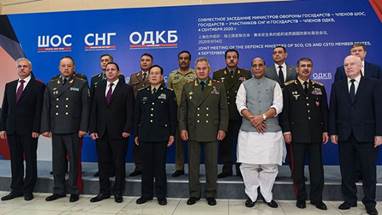
Disclaimer: Copyright infringement not intended.
Context
- Defence Minister Rajnath Singh is set to attend Shanghai Cooperation Organisation (SCO) Defence Ministers’ meeting scheduled to be held in Tashkent, Uzbekistan.
- During his visit, Mr Singh will hold bilateral meetings with Uzbekistan’s Defence Minister Lieutenant General Bakhodir Kurbanov along with other Defence Ministers of member countries of SCO.
- During his stay, Mr Singh will pay homage at the monument of Late Prime Minister Lal Bahadur Shastri and also meet the Indian Diaspora in Uzbekistan.
About SCO
- The SCO meeting is expected to deliberate on regional security challenges including the situation in Ukraine and Afghanistan.
- The SCO is an influential economic and security bloc and has emerged as one of the largest transregional international organisations.
- India and Pakistan became their permanent members in 2017.
- The SCO was founded at a summit in Shanghai in 2001 by the presidents of Russia, China, the Kyrgyz Republic, Kazakhstan, Tajikistan and Uzbekistan.
- India has shown a keen interest in deepening its security-related cooperation with the SCO and its Regional Anti-Terrorism Structure (RATS), which specifically deals with issues relating to security and defence.
- India was made an observer at the SCO in 2005 and has generally participated in the ministerial-level meetings of the grouping, which focus mainly on security and economic cooperation in the Eurasian region.
https://newsonair.gov.in/News?title=Defence-Minister-Rajnath-Singh-reaches-Tashkent-to-attend-SCO-Defence-Ministers%e2%80%99-meeting&id=446443
https://t.me/+hJqMV1O0se03Njk9
VL-SRSAM
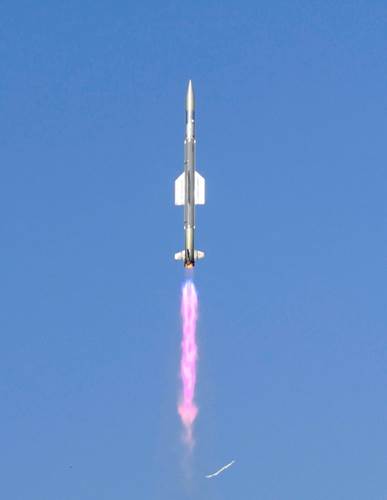
Disclaimer: Copyright infringement not intended.
Context
- Defence Research and Development Organisation (DRDO) and Indian Navy successfully flight-tested Vertical Launch Short Range Surface to Air Missile (VL-SRSAM).
- The missile was tested from the Integrated Test Range at Chandipur off the coast of Odisha. This missile has been indigenously designed and developed by DRDO.
About VL-SRSAM
- VL-SRSAM has been designed and developed jointly by three facilities of the Defence Research and Development Organisation for the deployment of Indian Naval warships.
- The missile has the capability of neutralising various aerial threats at close ranges including sea-skimming targets.
- The tactic of sea-skimming is used by various anti-ship missiles and some fighter jets to avoid being detected by the radars onboard warships. For this, these assets fly as close as possible to the sea surface and thus are difficult to detect and neutralise.
- The missile has been designed to strike high-speed airborne targets at the range of 40 to 50 km and an altitude of around 15 km. Its design is based on the Astra missile which is a Beyond Visual Range Air to Air missile.
- Two key features of the VL-SRSAM are cruciform wings and thrust vectoring.
- The cruciform wings are four small wings arranged like a cross on four sides and give the projective a stable aerodynamic posture.
- The thrust vectoring is an ability to change the direction of the thrust from its engine to control the angular velocity and the attitude of the missile.
- VL-SRSAM is a canisters system, which means it is stored and operated from specially designed compartments. In the canister, the inside environment is controlled, thus making its transport and storage easier and improving the shelf life of weapons.
https://newsonair.gov.in/News?title=DRDO-%26-Indian-Navy-successfully-flight-test-VL-SRSAM-off-Odisha-coast&id=446479
https://t.me/+hJqMV1O0se03Njk9
Metal and Mining Industry
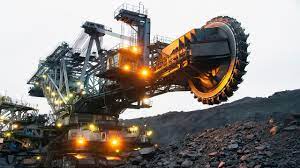
Disclaimer: Copyright infringement not intended.
Context
- Union Minister for Mines Pralhad Joshi, at the inaugurating International Conference on Indian Minerals and Metals Industry: Transition towards 2030 and Vision 2047 in New Delhi held that the government in the last eight years has laid the foundation for a Self-Reliant Atmanirbhar Metal and Mining Industry.
About Metal and Mining Industry in India
Metal:
- India is the 2nd largest crude steel producer in the world, with 120 MT of crude steel produced in FY’22.
- Production of Total Finished Steel stood at 111.858 MT showing a growth of 21.3% over the year.
- India Exported 13.5 MT of Finished Steel amounting to INR one lakh crores during FY’22
- Over 2030-31, crude steel actual production forecasted to reach 255 MT
- Per capita finished steel consumption is expected to rise to 160 kg by 2030-31 (from 72.3 kg in 2021)
- Steel production (weight: 17.92 %) increased by 3.3 % in June 2022 over June 2021. Its cumulative index increased by 6.6 % from April to June 2022-23 over the corresponding period of the previous year.
- Domestic stainless-steel demand is expected to reach 20 MT by 2047
- Secondary steel sector and consumers as the target of achieving 300 MT of steel capacity by the year 2030
Mining:
- India is home to 1,303 mines which reported mineral production (excluding atomic, fuel, and minor minerals) in 2019-20 and produce 95 minerals – 4 fuel-related, 10 metallic, 23 non-metallic, 3 atomic, and 55 minor minerals.
- India is the 2nd largest producer of coal, all India production in 2021-22 was 777.31 MT (P) with a growth of 8.55%.
- Coal is projected to remain the largest single source of electricity in India in 2040.
- Coal production (weight: 10.33 %) increased by 31.1 % in June 2022 over June 2021. Its cumulative index increased by 31.2 % from April to June 2022-23 over the corresponding period of the previous year.
The country’s FDI Policy for the metals and mining sector allows:
- 100% FDI through automatic route in the steel sector
- 100% FDI through automatic route in the mining sector
- 100% FDI for coal and lignite under automatic route
https://newsonair.gov.in/News?title=Union-Minister-for-Mines-Pralhad-Joshi-highlights-govt%26%2339%3bs-efforts-to-lay-foundation-for-Self-Reliant-Aatmanirbhar-Metal-and-Mining-industry&id=446457
https://t.me/+hJqMV1O0se03Njk9
Alternative Dispute Resolution
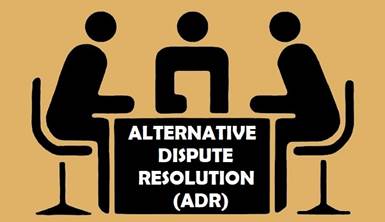
Disclaimer: Copyright infringement not intended.
Context
- India and the United Kingdom have agreed to exchange experiences and best practices in areas of working of commercial courts and Alternative Dispute Resolution (ADR) mechanisms like arbitration and mediation.
About ADR
- Alternative Dispute Resolution (ADR) refers to any means of settling disputes outside of the Court Room. The process by which disputes between the parties are settled or brought to an amicable result without the intervention of a Judicial Institution and any trial is known as Alternative Dispute Resolution (ADR).
- ADR offers to resolve all types of matters including civil, commercial, industrial and family etc., where people are not being able to start any type of negotiation and reach a settlement.
- Generally, ADR uses a neutral third party who helps the parties to communicate, discuss the differences and resolve the dispute.
- It is a method which enables individuals and groups to maintain cooperation, and social order and provides an opportunity to reduce hostility.
- ADR is a mechanism of dispute resolution that is non-adversarial, i.e. working together co-operatively to reach the best resolution for everyone.
- ADR can be instrumental in reducing the burden of litigation on courts while delivering a well-rounded and satisfying experience for the parties involved.
- It provides the opportunity to "expand the pie" through creative, collaborative bargaining, and fulfil the interests driving their demands.
https://newsonair.gov.in/News?title=India%2c-UK-agree-to-exchange-experiences%2c-best-practices-in-commercial-courts%2c-Alternative-Dispute-Resolution-mechanisms&id=446462
https://t.me/+hJqMV1O0se03Njk9
Central Zonal Council
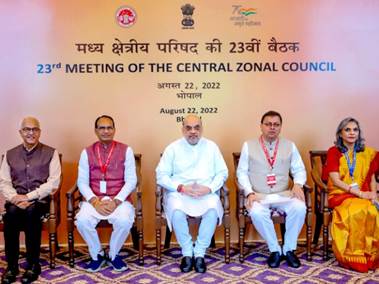
Disclaimer: Copyright infringement not intended.
Context
- Union Home Minister Amit Shah chaired the 23rd meeting of the Central Zonal Council in Bhopal. Addressing the meeting, the Union Home Minister said, our government is dealing strictly with the problem of Left-Wing Extremism in the Naxalite affected areas included in the Central Zonal Council.
About Central Zonal Council
- The idea of the creation of Zonal Councils was mooted by the first Prime Minister of India, Pandit Jawahar Lal Nehru in 1956 when during debate on the report of the States Re-organisation Commission, he suggested that the States proposed to be reorganised may be grouped into four or five zones having an Advisory Council "to develop the habit of cooperative working” among these States.
- In the light of the vision of Pandit Nehru, five Zonal Councils were set up vide Part III of the States Re-organisation Act, 1956. The present composition of each of these Zonal Councils is as under:
- The Northern Zonal Council, comprising the States of Haryana, Himachal Pradesh, Jammu & Kashmir, Punjab, Rajasthan, National Capital Territory of Delhi and Union Territory of Chandigarh;
- The Central Zonal Council, comprising the States of Chhattisgarh, Uttarakhand, Uttar Pradesh and Madhya Pradesh;
- The Eastern Zonal Council, comprising the States of Bihar, Jharkhand, Orissa, and West Bengal;
- The Western Zonal Council, comprising the States of Goa, Gujarat, Maharashtra and the Union Territories of Daman & Diu and Dadra & Nagar Haveli; and
- The Southern Zonal Council, comprising the States of Andhra Pradesh, Karnataka, Kerala, Tamil Nadu and the Union Territory of Puducherry.
- The North Eastern Statese. (i) Assam (ii) Arunachal Pradesh (iii) Manipur (iv) Tripura (v) Mizoram (vi) Meghalaya (vii) Nagaland and (viii) Sikkim are part of North Eastern Council, set up under the North Eastern Council Act, 1972.
- Organisational structure of zonal councils:
- Chairman: The Union Home Minister is the Chairman of each of these Councils.
- Vice Chairman: The Chief Ministers of the States included in each zone act as Vice-Chairman of the Zonal Council for that zone by rotation, each holding office for one year at a time.
- Members: Chief Minister and two other Ministers as nominated by the Governor from each of the States and two members from Union Territories included in the zone.
- Advisers: One officer nominated by the Planning Commission for each of the Zonal Councils, Chief Secretaries and other officers/Development Commissioner nominated by each of the States included in the Zone;
https://newsonair.gov.in/News?title=Union-Home-Minister-Amit-Shah-chairs-23rd-meeting-of-the-Central-Zonal-Council-in-Bhopal&id=446442
https://t.me/+hJqMV1O0se03Njk9









